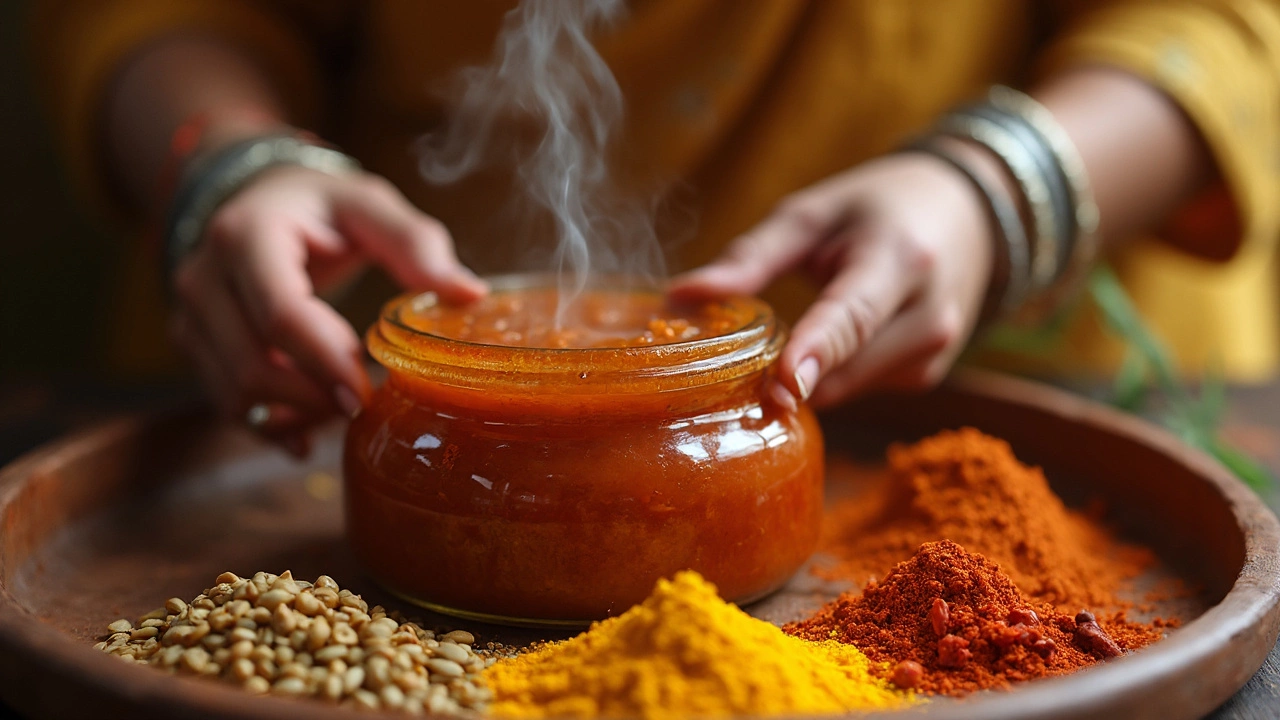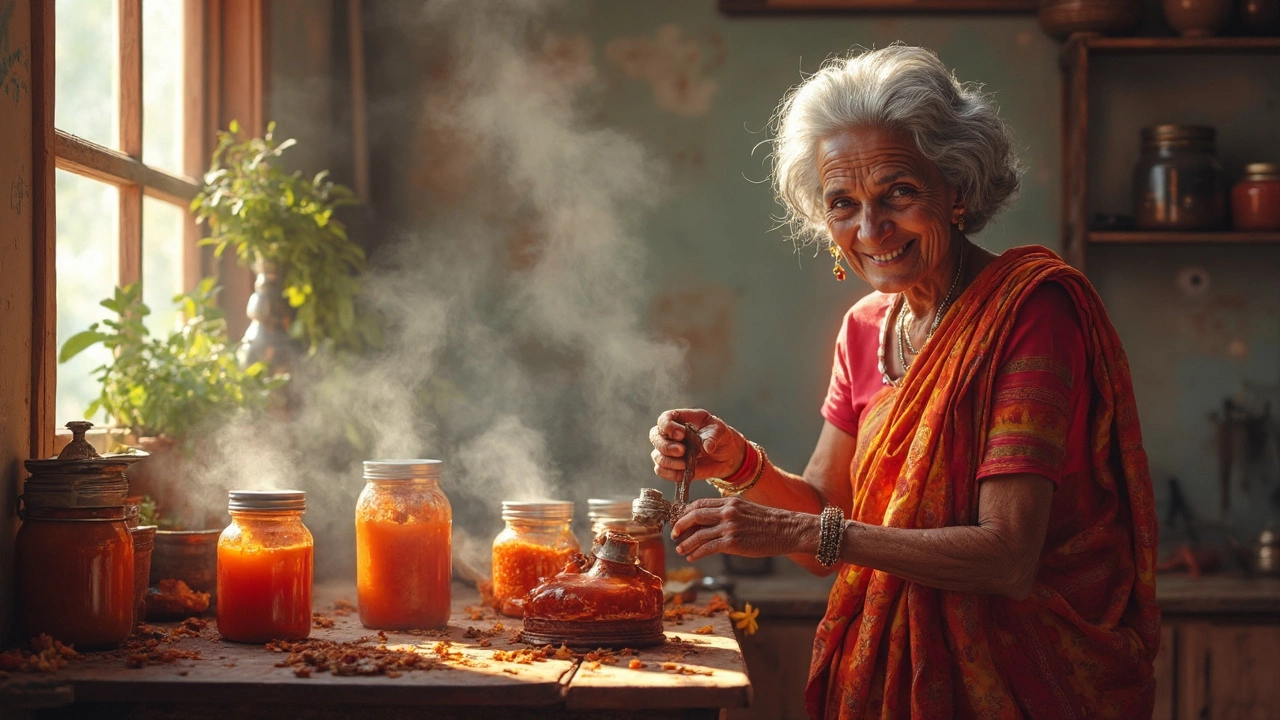21 Feb 2025
- 0 Comments
Sealing a jar of chutney while it's hot might seem like a no-brainer, right? But the questions that usually come up: Is it safe? Does it affect the taste? Well, you're not alone in your curiosity. Let's unpack this spicy mystery.
First off, sealing those jars while hot is actually an old-school trick to ensure the lid seals properly as it cools down. It's pretty simple! The heat creates a vacuum seal, keeping your chutney fresher for longer. But still, there are things to watch out for.
- The basics of chutney sealing
- Why temperature matters
- Common mistakes in chutney preservation
- Safety tips for sterilizing jars
- Keeping your chutney fresh and flavorful
The Basics of Chutney Sealing
So, you've cooked up a batch of your favorite chutney. Now comes the technical part: sealing. Let's talk about why this step is critical for keeping your chutney lasting and safe to eat.
Why Sealing Matters
When you pour your hot chutney into jars and seal them right away, you're creating a vacuum seal. This seal is crucial, as it helps to prevent any unwanted bacteria or mold from getting in and ruining your delicious creation. A good seal keeps your chutney preserved and tasting as fresh as the day you made it.
Steps for Proper Sealing
- Start with clean, sterilized jars. This means washing them with hot soapy water and then boiling them for about 10 minutes. Clean jars are a must!
- Fill your jars with hot chutney, leaving about a half-inch of space at the top. This space helps with the vacuum-sealing process.
- Wipe the rim of each jar with a clean, damp cloth. You want to make sure there's no chutney around the rim that can prevent sealing.
- Place the lids on and screw the rings on tightly but not over-tight. You want to let air escape as the jar cools down to form a good vacuum.
- As the jars cool, check the lids. If they're concave, you've done it right! If not, you might need to repeat the process.
Common Pitfalls
Don't let minor slip-ups spoil your hard work. Here's a quick list of things to avoid:
- Not leaving enough space in the jar for the jam to expand.
- Skipping the sterilization step — seriously, don't!
- Overfilling jars which can prevent a proper seal.
If you're into numbers, here’s how proper sealing can actually extend the quality life of your chutney:
| Sealed Properly | Sealed Improperly |
|---|---|
| Up to 12 months | 3-6 months |
Why Temperature Matters
Alright, so why is temperature such a big deal when we're talking chutney recipes and jar sealing? Here’s the lowdown: the heat helps eliminate unwanted microorganisms that could spoil your chutney. It’s like a little cleanse for your jars, making sure that no nasties can ruin your flavorful creations.
The Science Behind Sealing
Once you pour that hot chutney into sterilized jars and pop the lids on while it’s still steaming, the temperature does most of the heavy lifting. As it cools, it creates a vacuum seal. This is important because it keeps air – and all those sneaky bacteria – out. The vacuum seal basically secures your chutney, enhancing both the shelf life and taste.
Temperature and Taste
A common worry is whether heat affects the taste or texture. In most cases, sealing hot helps preserve the flavor just as you intended. But, here's a tip: don’t boil to the point where it alters your chutney’s taste. You're aiming for hot, not scalding.
Safety First
Using a thermometer can help keep things in check. Most experts suggest pouring chutney at around 185°F. It’s hot enough to do the job without going overboard.
Got more questions about keeping your chutney fresh and flavorful? Let's move on to common mistakes you might be making when preserving your beloved chutney.

Common Mistakes in Chutney Preservation
Making chutney is like an art form, but even the pros trip up sometimes. When it comes to chutney preservation, a few common missteps can turn your zesty masterpiece into a culinary flop. Let's tackle those errors and make sure your chutney is always in top shape!
1. Ignoring Proper Sterilization
One major mistake is skipping the sterilization step. If your jars aren't squeaky clean, they can welcome unwanted bacteria and spoilage. Sterilize jars by boiling them (and the lids) in water for at least 10 minutes. This kills off any nasties that might be lurking around.
2. Not Using the Right Jar Type
All jars are not created equal. Using improper jars, like those with reused lids, can mess up the sealing process. Opt for proper canning or mason jars with new lids to ensure the seal holds tight.
3. Filling Jars to the Brim
Avoid filling jars all the way to the top. Leave some headspace, about half an inch, to allow for expansion. This prevents leakage or poor sealing.
4. Skipping the Boiling Water Bath
This step is crucial for creating a solid vacuum seal, especially if you're storing chutney for longer periods. After sealing, immerse the jars in a boiling water bath for 10-15 minutes. It might seem like overkill, but it works wonders for long-term preservation.
5. Neglecting Temperature Concerns
Preserving at the wrong temperature can ruin the texture and flavor of your chutney. Always make sure your chutney is hot when you pour it into the jars and seal them immediately. This helps in forming a reliable seal and keeping unwanted bacteria at bay.
6. Table of Most Common Preservation Mistakes
| Common Mistake | Impact |
|---|---|
| Ignoring Sterilization | Causes spoilage |
| Using improper jars | Seals don't hold |
| Filling to the brim | Risk of leakage |
| No boiling water bath | Poor preservation |
| Wrong temperatures | Compromised flavor |
Avoiding these mistakes ensures that your chutney recipes stand the test of time and taste. With these tips in your back pocket, you'll keep churning out flavorful, perfectly preserved chutney every time!
Safety Tips for Sterilizing Jars
Properly sterilizing your jars is a crucial step to ensure your chutney recipes are safe and tasty over time. Believe it or not, skipping this might expose your chutney to harmful bacteria, turning your delightful preserve into a disaster.
Why Sterilization is Key
Ever wonder why we make such a fuss about clean jars? It's because food preservation depends on it. Even the tiniest bit of leftover bacteria can spoil your masterpiece, without you even knowing. Plus, a properly sealed jar keeps your chutney free from air and moisture, which are germ hotspots.
Step-by-Step Guide to Sterilizing
- Wash the Jars: Start by washing your jars and lids in hot, soapy water. Rinse them well to remove any soap residue.
- Boil Water: Set a large pot of water to boil. Make sure there's enough room to submerge all your jars completely.
- Sterilize: Place the jars into the boiling water for at least 10 minutes. More time doesn’t hurt, especially if you're in a high-altitude area.
- Dry the Jars: Carefully remove the jars, placing them upside down on a clean dish towel to dry. Don't be tempted to dry them with a cloth as this can introduce lint or bacteria.
- Sterilize Lids: Pop the lids into the pot of hot water for a few minutes, then let them dry naturally.
The Temperature Factor
Temperature plays a shady role here too, especially if you're wondering why it's important to seal jars during hot cooking. This process works magic when the hot chutney meets your sterilized jar, creating a vacuum seal as it cools.
Common Pitfalls to Avoid
Avoid using old or damaged jars, as tiny cracks can ruin the seal. Also, remember to check your lids’ rubber seals. If they're worn out, it’s best to replace them.
By following these sterilization tips, you ensure not just safety but also maintain the irresistible flavors and freshness of your homemade chutney.

Keeping Your Chutney Fresh and Flavorful
When it comes to preserving your chutney so it's just as tasty months later, there are a few things to keep in mind. Nobody wants to go through all that effort just to end up with a bland or off chutney! Let's dive into some practical tips.
Start with Cleanliness
Cleanliness is crucial. Before you even think about putting your aromatic masterpiece into a jar, make sure everything is squeaky clean. This means sterilizing your jars properly. To do this, you can boil them in water for at least 10 minutes or pop them in the oven at 275°F (135°C) for 20 minutes.
Seal it Right
The seal is what makes or breaks your jar sealing efforts. Ensure the lids are on tight but not overly cranked down. As the jars cool, a vacuum seal should form. You might hear a satisfying 'pop'—music to any chutney maker’s ears!
Store Wisely
Once your jars are sealed and cooled, store them in a cool, dark place. A pantry or cellar works great. Heat and light can cause your chutney to spoil faster. If stored right, your chutney can last up to a year, maybe even longer!
Label Everything
Don’t forget to label your jars. Include the date it was made and maybe even the flavour or spice level. Believe me, future you will thank present you when you're rummaging through your pantry.
Testing the Checkpoints
Finally, before serving, give your chutney the once-over. Is the seal still intact? Does it look and smell right? If it passes these tests, dive in and enjoy your tangy creation!
By following these tips, your chutney recipes will stay delicious and safe for everyone to enjoy. Happy preserving!
